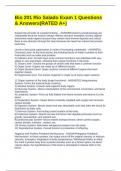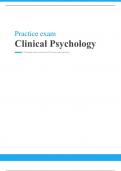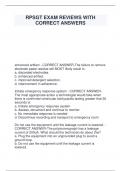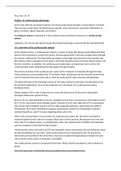Turcinhodzic
Chapters Murphy
Chapter one: Introducing the landscapes of criminology
Criminology: the study of crime, justice, and law and order issues, and the broader dynamics of societies in
terms of informing how those things exist and are experienced.
↳ The definition is influenced by the context of the methods or tools employed in seeking to
understand issues and do something about them. Meaning: in addition to studying crime, justice and law
and order processes, there is also consideration of wider processes which in some way have an impact on
those things.
↳ The following must also be considered: the social and cultural context, the political climate, the
nature of the economy, processes such as globalization and technological progress, a human rights agenda
etc. ➝ The field of criminology is therefore interdisciplinary in nature
↳ Example topics or issues in the field: causes of crime, class power and inequality, human rights,
types of crime, victimization etc.
Skills and competencies of a criminologist
1. Finding appropriate materials: always use credible sources within your work, who are credible and
their work has been checked
2. Using materials in an appropriate way: regardless of the source, it is important to ask from where
it has come (is there a purpose, agenda or preconceived position influencing what is
written/evidence to support the discussion or not) ➝ evidence-driven
3. Being a critical enquirer: approaching topics, arguments, and sources of material with a natural
curiosity for what it tells us, but also what it does not tell us
4. Being a reflective learner: actively stopping and taking stock if your own learning, work, skills and
gaps (ask yourself what has gone well/what has not)
5. Being a pragmatic researcher: using different approaches and methods when selecting/searching
for the evidence and best tools for the job (different types of data, materials, methods etc.)
6. Being digitally competent: using online materials, social media, databases and applications for the
purpose of accessing information, undertaking research and spreading the work
7. Being an advocate for change: it is important to want to see positive change in some way (this
could be in terms of the criminal justice system, ensuring people’s rights, challenging corruption
and so on)
Gibbs’ cycle of reflection
1. First describe what happened in a situation
2. Consider your feelings and thoughts at the time
3. Evaluate what was good and bad about the experience(s)
4. Do an analysis in terms of what sense you can make of the situation
5. Form a conclusion in terms of what else you could have done
6. Develop an action plan for what you would now do
Criminal justice systems (CJS): important feature that is the process through which the state responds to
behavior that it deems unacceptable
,↳ criminal justice is delivered through a series of stages: charge, prosecution, trial, sentence, appeal,
punishment ➝ these processes and the agencies which carry these stages out are referred to collectively as
the criminal injustice system
Crime: an intentional act which breaks or goes against a law of some sort (legal definition)
↳ Range of issues must be considered: where have laws come from? / What are the consequences of the
laws we have? / Who is affected by the laws? Etc.
↳ Laws are not fixed or static ➝ new laws can be made and old repealed ➝ what is understood to be
‘crime’ must then also be fluid
↳ The decision to criminalize certain behaviours has to be influenced by something
(public/media/groups/politics/social and cultural attitudes/technology etc)
Meaning: things only become defined as ‘crime’ once there has been enough reason for the State to react
to it
The moral and social context of crime
Many damaging behaviours are not criminalized, while some groups in society are disadvantaged by the
laws (criminalization of homosexuality/abortion)
Socially constructed nature of crime: how much of what is viewed as ‘crime’ is a product of the dynamics
of a given society at a given point in time
Deviancy: acts that are outside of the mainstream values and norms of society (does not have to illegal
behavior, just enough react to it for it to become formally criminalized)
Chapter five: Counting crime
How crime is defined impacts on what exactly is measured and how
↳ if there are different ways of defining what crime is, this means that the actual behaviours
determined to be criminal or harmful can vary and leads to different outcomes
↳ This becomes a subjective process
How do we count crime?
1. Official crime data from agencies who have some direct involvement in dealing with law and
order issues
2. Information from victimization survey work
3. Asking a representative sample by questioning about experiences involving crime (self-report
surveys)
4. Data from non-governmental organisations and investigative journalism
* 1 and 2 are the main sources for counting crime, the other two are additional
Critique of official statistics on crime
↳ Data is lost: The data is a product of a series of processes: recognizing, reporting and recording ➝ In
order for a crime event to end up in the data, it has gone through these stages, and at each point there is a
chance that the event is lost from the eventual total
, ↳ Unrecorded crimes: the volume of crime that is in the shadows is lost to the total, therefore not the
complete picture that it is in truth
Hurdle of recognition: the need for a crime to be recognized as having taken place, or recognition of the
behaviours which has occurred being illegal in the first instance may not be met because people might not
notice their victimization (not keeping track of own possessions or triviality of an events etc.)
Hurdle of reporting: not all crimes that are recognized are reported ➝ victims may distrust the
police/want to deal themselves/think it too trivial/feel embarrassment/be linked to something illegal
themselves when it occurred etc.
Hurdle of recording: only a fraction of the total amount of crime that we think has taken place ends up
within the records ➝ there may not be enough evidence/the police might distrust a reporter/not wanting
to include an offence in a particular category/priorities and targets etc.
Social constructionist lens: the way a crime is viewed, counted and reported is influenced by the cultural
and social baggage/view the police for example has (in terms of how events are determined to be criminal
offence or not)
Victimisation survey Police records
Strenghts Strenghts
Large sample provides a good measure of long- Has wider offence coverage and population
term crime trends for the offences and the coverage
population it covers
Consistent methodology over time Good measure of offences that are well reported
and recorded by police
Covers crimes not reported to the police and is Primary source of local crime statistics and for
not affected by changes in police recording lower-volume crimes (e. homicide)
practice
Independent collection of crime figures Provides whole counts (rather than estimates that
are subject to sampling variations)
Include children aged 10 to 15 years resident in Time lag between occurrence of crime and
households reporting results tends to be short, providing an
indication of emerging trends
Limitations Limitations
Survey is subject to error associated with sampling Excludes offences that are not reported to/by the
and respondents recalling past events police and does not include less serious offences
Potential time lag between occurrence of crime Trends can be influenced by changes in recording
and survey data collections means that the survey practices or police activity as well as public
is not a good measure of emerging trends reporting of crime
Excludes crimes against businesses and those not Not possible to make long-term comparisons due
resident in households to fundamental changes in recording practices
(ending 2003)
Headline estimates exclude offences that are There are concerns about the quality of recording







